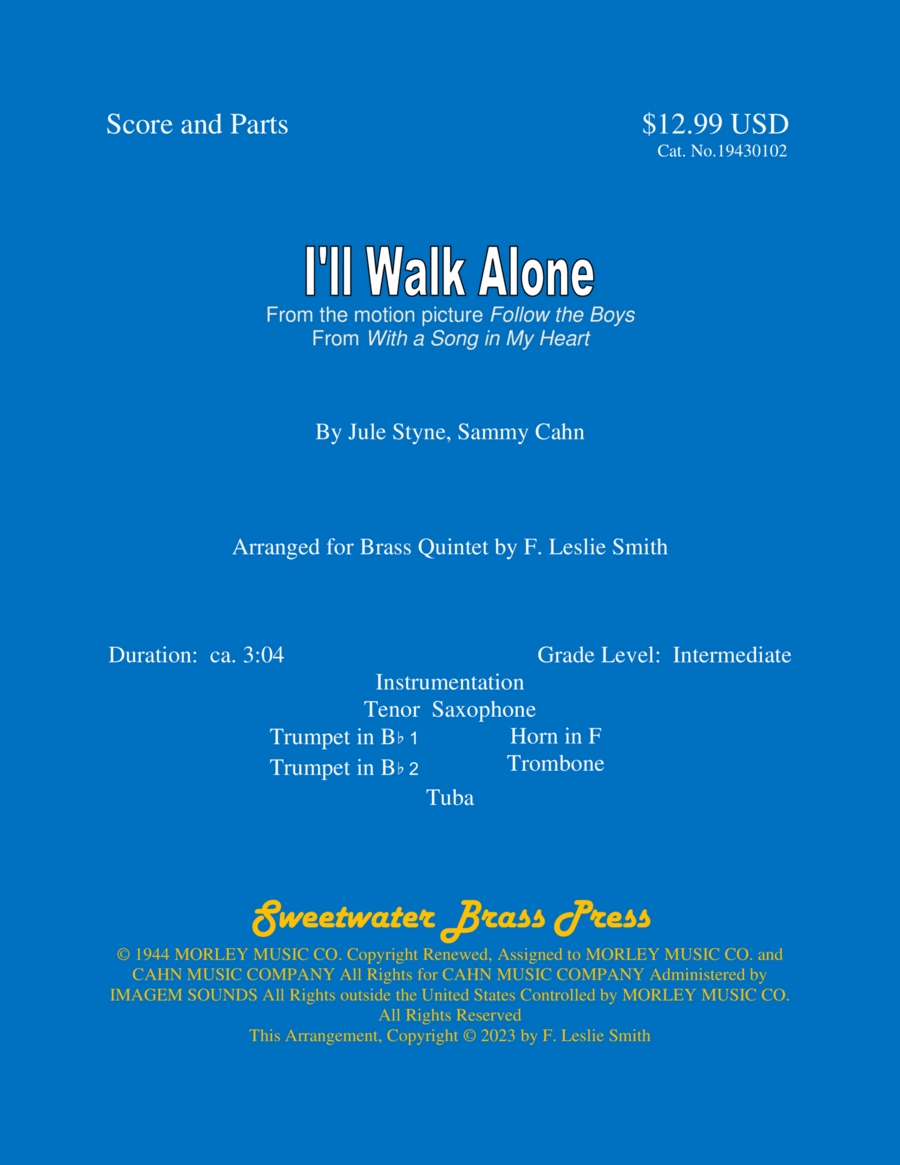Horn,Tenor Saxophone,Trombone,Trumpet,Tuba - Level 3 - Digital Download SKU: A0.1351942 By Dinah Shore. By Jule Styne and Sammy Cahn. Arranged by F. Leslie Smith. 20th Century,Jazz,Pop,Standards. 20 pages. Sweetwater Brass Press #936564. Published by Sweetwater Brass Press (A0.1351942). âIâll Walk Aloneâ is a World War II era ballad whose poignant melody sounds as though it could have been written just yesterday.  First introduced in the 1944 movie Follow the Boys, it was hugely popular and has since been recorded by numerous artists.   Universal Pictures produced Follow the Boys in an effort to help boost morale for both overseas military and folks on the home front.  Despite being filled with stars and songs, critics tended to dismiss it as hokey and trite.  The exception was a scene in which Dinah Shore sang âIâll Walk Alone.â  Nominated for the Academy Award for Best Original Song, Ms. Shoreâs follow-up Victor recording spent 20 weeks on the top ten Best Selling Records chart.  The song was used yet again in 1952 for another motion picture, With a Song in My Heart, the Jane Froman biographical film, and the melody eventually developed as a standard, particularly in the world of jazz.   Sammy Cahnâs lyrics for this song express the feelings and the promise of a woman who has been separated from her lover by the war.  She pledges that she will be true, that she will wait for him, and that â'till you're walking beside me, I'll walk alone.â  Jule Styneâs melody is both plaintiff and simple. an eight-measure phrase, a repeat of the phrase, an eight-measure second phrase, then another repeat of the first phrase.   For this arrangement, the suggested tempo is a relatively slow, blues-like 72 bpm.  It features a tenor saxophone as lead and solo instrument accompanied by brass quintet.  A four-measure introduction opens the piece with Trumpet 1 playing melody and the other four brass providing background.  Following the intro, Tenor Sax plays its first three notes alone; the other instruments begin their accompaniment on measure 6.  Trumpet 1 is tacit during measures 6-11 but begins adding counterpoint in measure 12.     In performing this arrangement, brass instruments should ensure that, when the Sax plays, their volume as a group is under (i.e., softer than) the melody.  The exception begins at measure 36, when a crescendo leads to the quintet playing fortissimo.  During this section, the Tenor Sax plays a couple of responses.  At measures 43 a decrescendo lowers the brass volume back to its original soft accompaniment level.  The piece ends with brass recapping the introduction and Sax providing a final statement.   This piece, completed in 2023, consists of 57 measures, a little over three minutes in length.  Written in the key of G major, Tubaâs lowest note is a G below the staff.  Other than that, all notes are well within the normal playing range of each instrument.   The arranger, Les Smith, will be happy to provide substitute parts (for example, treble clef baritone for trombone) at no charge.  He would like to receive your suggestions, comments, corrections and criticisms.  Contact him at lessmith61@bellsouth.net.  For more arrangements by Les, enter Sweetwater Brass Press (without the quotation marks) in the Sheet Music Plus or Sheet Music Direct search box.
